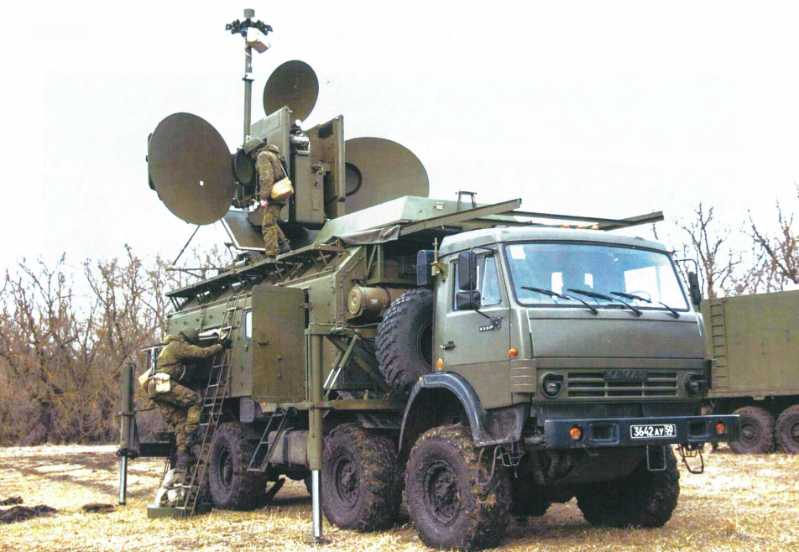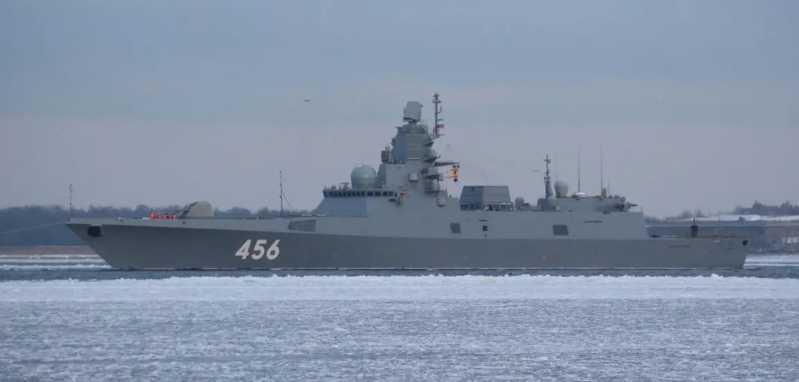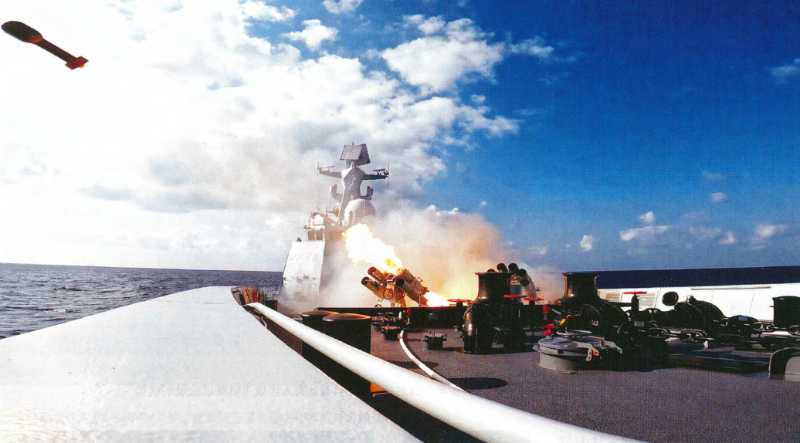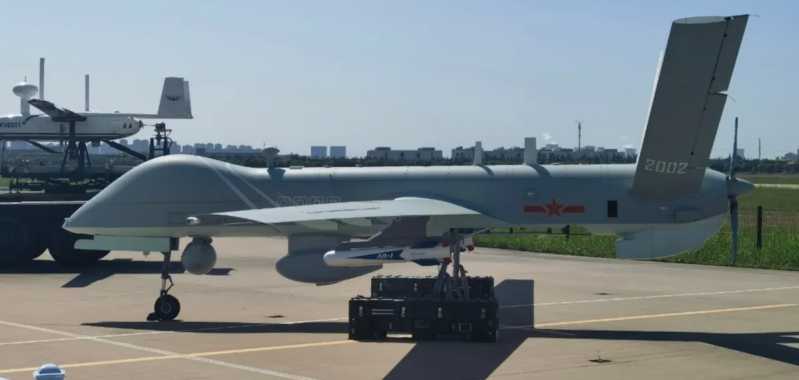At the end of last year, the U.S. Department of Energy’s Sandia National Laboratory released an annual summary video that actually included an image of an F-16 with a B61-12 nuclear bomb under its wing. Based on the unique design of the reinforced aircraft shelter on the left side of the F-16 in the video image, relevant people analyzed that this F-16 Viper fighter seemed to be parked at Volkel Air Force Base in the Netherlands, with an inert training bomb of the B61-12 nuclear bomb under its wing. As part of the NATO nuclear sharing agreement, this allows people to glimpse the United States’ work on deploying the latest nuclear bombs in Europe.

B61 nuclear bomb
B61 nuclear aerial bomb is a multi-purpose tactical nuclear bomb for fighter jets developed by the United States during the Cold War. It was designed by the Los Alamos National Laboratory in New Mexico and equipped to the troops in 1966. The bomb weighs 315-324 kg, has a body length of 3.3 meters, a body length (including wings) of 3.59 meters, a body diameter of 340 mm, and a tail wingspan of 572 mm. All B61 nuclear bombs have two basic types, the "strategic" version is suitable for larger urban-scale targets, and the "tactical" version is suitable for smaller sites, and may even be used on the battlefield against enemy concentrated forces. The only real difference is the available and selectable options.
The structure of the B61 nuclear bomb is a dual-channel radar air-blast fuze and two piezoelectric crystal impact fuzes and impact buffer materials in the head; the nuclear warhead, thermal battery, safety protection device and ignition circuit in the middle of the bomb body, and the rear is equipped with pre-flight insurance control, fuze selection switch, safety separation regulator, spin-stabilized rocket, nylon/Kevlar-29 spiral parachute with opening device, and bomb wings. The nuclear warhead adopts a two-stage radiation implosion type, with a plutonium and beryllium reflector layer and deuterium-tritium gas thermonuclear reinforcement on the outside, and an enriched uranium and lithium deuteride (Li-6, 95% concentration) thermonuclear component on the inside. The explosive detonation device is made of PBX-9502 insensitive high-energy explosive (1HE). Of course, its adjustable explosive yield is a great improvement.
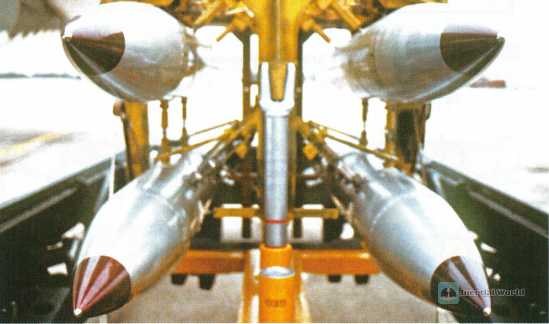
The "strategic" version of the original B61-0 and -1 weapons has a yield of 10 to 300 kilotons. It is reported that the B61-1 differs from the first version mainly in that it lacks any form of licensed operation link safety device (PAL). The B61-0 has a "Class B" device consisting of an electromechanical switch that will only work and arm the weapon when the appropriate four-digit code is entered. On the aircraft, the crew can do this in flight using a wired connection to the bomb, allowing troops to release aircraft carrying live weapons in an emergency, but with the added safeguard that the detonation cannot be released until the order to actually attack is received. A separate control panel on the aircraft controls the burst altitude and delayed detonation functions, including, in combination with a parachute or parachute deceleration system, allowing low-flying, fast-flying fighters to drop the bomb while still safely escaping the blast area. The B61-1’s lack of PAL safety features may have something to do with the fact that some of the 700 nuclear bombs were stored for use by NATO allies in a crisis, and that U.S. personnel would need to obtain the code and then pass it on to third-party personnel, a process that was too time-consuming to form a credible deterrent capability. Each subsequent bomb was equipped with some type of PAL, as well as a manual "command disable" system that ground personnel could use to completely disarm the weapon in an emergency.
235 The B61-2 is a tactical variant with a yield range of 10 to 150 kilotons and features a Class D PAL, which requires a six-digit code that the operator has only one chance to enter correctly before the system locks up, and can accept multiple code sequences that either set the weapon to a "safe" training mode or disable it if necessary. The B61-3 and -4 have Class F PALs, which use 12-digit code sequences to allow multiple attempts. These devices also tie these codes to the desired yield, allowing the crew to set it up in flight. Both bombs were also the first weapons to use insensitive explosives in the warhead to initiate a nuclear reaction, greatly improving safety. The B61-3 has eight separate yield settings: 0.3, 1.5, 5, 10, 45, 60, 80, or 170 kilotons. The B61-4 has fewer options, ranging from 0.3 to 50 kilotons. The United States built nearly 550 and 700 B61-3 and B61-4 bombs, respectively. The B61-5 has the same yield as the B61-1, but with the addition of a Class D PAL. These 265 bombs are also the first to feature the Enhanced Nuclear Explosive Safety (ENDS) feature, which better protects the bomb from physical shock, extreme temperatures, electromagnetic interference, and any other "anomalies".
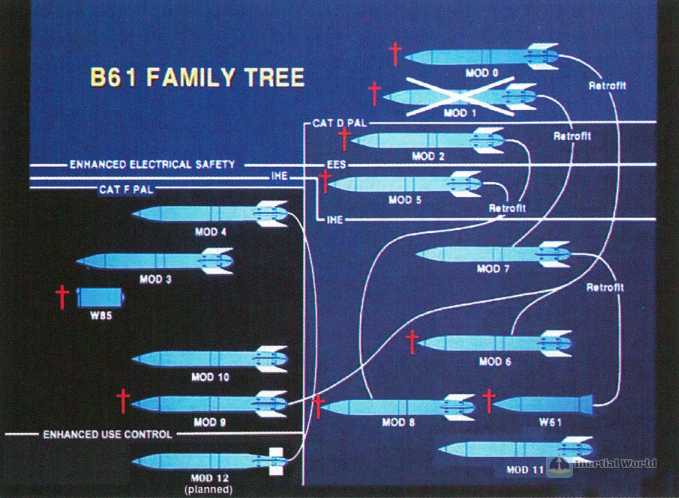
Except for the B61-10, all subsequent versions are upgrades of the previous bombs. The B61-0 was originally the basis for the development of the B61-6 and B61-9, which had Class D and Class F PALs, respectively, but the US government canceled these projects. Plans to convert the older B61-2 and B61-5 into B61-8s with warheads with insensitive explosives also did not come to fruition. In the 1980s, the remaining 600 B61-1s were equipped with Class D PALs and warheads with ENDS and insensitive explosives to become the B61-7, which also had a slightly increased maximum yield of about 340-360 kilotons. Only the B61-10 is a bit special. When the U.S. military was developing the Pershing II tactical short-range ballistic missile, it improved the warhead of the B61-4 to become the W85, which has a selectable yield of 5 to 50 kilotons. But in 1987, the United States and the Soviet Union signed the Intermediate-Range Nuclear Forces Treaty (INF), dismantling the Pershing 11. Therefore, the U.S. government converted the W85 into 215 B61-10s, with yields ranging from 0.3 to 80 kilotons, and installed F-class PALs.
The B61-11 was put into use in 1997. Based on the warhead of the B61-7, it is the first tactical and strategic combination bomb that is significantly different from earlier bombs in form and function, with a single maximum yield of about 340-400 kilotons. The bigger difference is that it has a significantly reinforced shell, possibly with a depleted uranium ground-penetrating head, a delayed fuze system, and a booster rocket engine at the rear, which can strike deeply buried reinforced facilities. According to public data, there are less than 100 such bombs in existence, and they are mainly intended to attack the Kosvinsky Kamen bunker in Russia. Therefore, the ability to drill into the ground reaches 3-6 meters. The high-temperature and high-pressure fireball formed after the nuclear explosion forms a shock wave of millions of atmospheres in the soil and rock medium. The soil and rock medium after the shock compression will liquefy and compress the surrounding rocks to form a cavity. The strategic target is destroyed by generating a concentrated shock effect on the top of the reinforced underground fortifications.
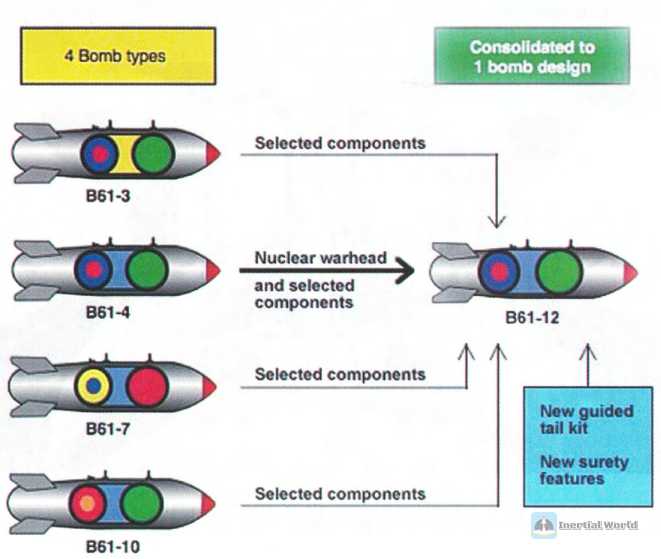
The latest B61-12 is different from previous nuclear bombs in appearance. The B61-12 has been under development since at least 2011. It is equipped with GPS-Inertial Navigation System (INS) guidance and a tail kit with two rotating rocket engines to improve the stability of the bomb’s longitudinal axis during descent. Its form and function are similar to the Joint Direct Attack Munition (JDAM) bomb. It is said that LEP has greatly improved the accuracy of the B61, with a reported circular error probability of 30 meters instead of the original 100 meters. The warhead uses an improved B61-4, which also has an adjustable yield from 0.3 to 50 kilotons. The US military expects to complete the production of the B61-12 bomb by the end of 2024 (experts believe that the total number will be between 400 and 500) and replace the existing B61-3, -4, -7, and -11 bombs, but the bomb should not have the ability to drill into the ground. After the B61-12 is combat-ready, the B83-1 and B61-11 will be considered for gradual retirement.
In 2012, the official cost estimate of the B61-12 soared from $4 billion to $10 billion. This figure does not include the funds required to develop the tail kit ($1.2 billion) or other components. If at least 400 weapons are needed to fully replace the existing bombs, this means that each bomb will actually be worth more than its weight in gold. Since the B61-4 warhead is required, but only 200 are actually available, the US government must select another 200 to 300 warheads and ensure that they are in safe and normal working condition before they can begin to upgrade them to the new B61-12 configuration. In the face of the US military’s newly developed air-launched cruise missiles that can carry nuclear warheads and large conventional precision-guided bunker-busting bombs, the B61-12 technology may be relatively old and still needs to be mounted on aircraft, but it can carry a large number of weapons at a time and can also perform deterrence flights, so it is more flexible in mission execution.
What is the purpose of the B61-12 mounted on European F-16?
Volkel Air Force Base in the Netherlands is one of several bases where the US military retains B61 nuclear bombs in Europe. As part of the NATO nuclear weapons sharing agreement, these B61 nuclear bombs may be shared with selected NATO member states for their aircraft to mount. Eleven of the 32 hangars at Volkel Air Force Base are equipped with underground weapons storage and security system vaults, each of which can accommodate up to 4 B61 bombs. But normally, each bomb hangar can only accommodate 1-2 bombs, and the base is estimated to have 10-15 bombs.
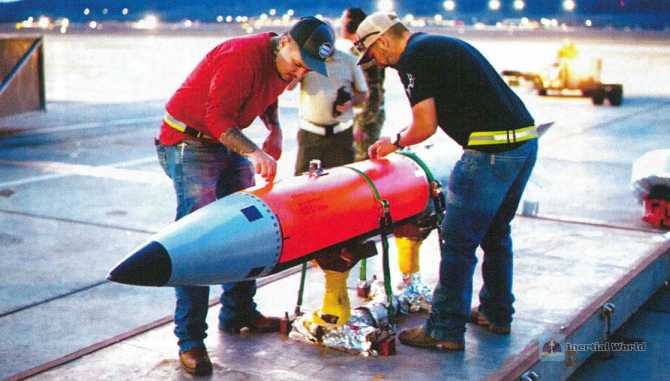
It is not clear whether the F-16 in the picture belongs to the Royal Netherlands Air Force, which is currently transitioning to the F-35A Joint Strike Fighter and expects to retire the last F-16 fighter next year. In November, the head of the Netherlands Air Combat Command announced that the country’s F-35A fleet had received "preliminary certification for the deterrence mission." If the photo was indeed taken in 2021, it would be before the first production B61-12 nuclear bombs were delivered and officially entered service. Preparations for the deployment of these weapons in Europe have been underway for years. In October 2022, Politico reported that the first B61-12 samples were scheduled to arrive in Europe this month. It is not clear whether Europe has any B61-12s in service.

According to the official information released so far, only the US Air Force B-2 stealth bomber is currently approved to use the B61-12. The Air Force’s F-15E Strike Eagle and F-35A Joint Strike Fighter, as well as the service’s future B-21 stealth bomber, will also become combat delivery platforms for these nuclear bombs. In addition, the B61-12 is expected to be integrated into some NATO and US Air Force F-16 fighters. In addition to the F-16s in service with the Netherlands, some Belgian F-16s are currently authorized to carry older B61 variants under NATO nuclear sharing arrangements. Some Tornado fighters in service with Germany and Italy are also capable of serving as nuclear weapon delivery platforms.

But it is worth noting that the US and NATO F-16s and NATO Tornado fighters will not be able to use the guidance function on the B61-12. This issue may be increasingly moot. At present, all known NATO member states that have signed nuclear sharing agreements have or are purchasing F-35 fighters to replace their F-16s and Tornado fighters. Therefore, countries are also actively promoting the expansion of the use of US B61 nuclear bombs on their F-35As. NATO members that previously participated in the alliance’s nuclear weapons sharing arrangement have historically been very cautious about the matter, but the Americans claim that there has been a clear shift in attitude since the outbreak of the Russo-Ukrainian war in February 2022. This shift has become more obvious since the Russian military deployed nuclear weapons on the front line in neighboring Belarus earlier this year, with Poland being the most active, as it borders Belarus and Russia’s Kaliningrad exclave.
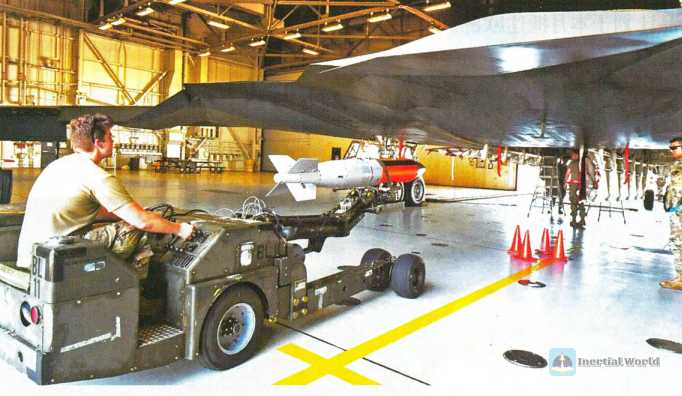
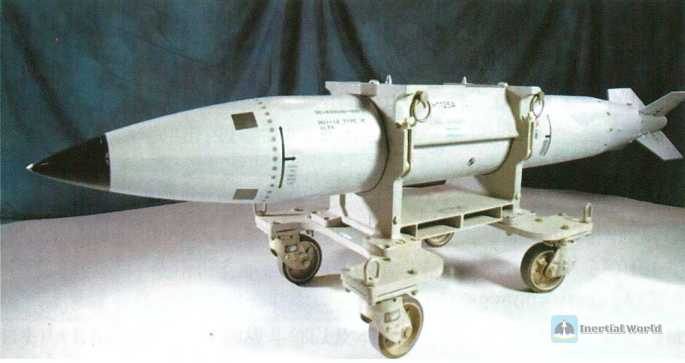
In any case, the picture that appeared this time shows that the United States is still committed to maintaining the inventory of B61 nuclear bombs for decades to come. The B61-12 nuclear bomb mounted on NATO fighters also means that the strike force that can use the B61-12 nuclear bomb has become more diversified, which means that it will become the weapon of choice for the US military to carry out nuclear strikes. By mounting it on US fighters and stealth bombers, taking off from NATO countries and East Asian countries such as Japan and South Korea, it will have a strategic-level strike range against China and Russia. Therefore, it has both tactical and strategic strike capabilities, which will further enhance the US military’s nuclear deterrence and nuclear strategic advantages, while blurring the boundaries between tactical weapons and strategic weapons. This will make it easier for Americans to decide to use nuclear bombs, thereby putting China, Russia and other countries that are hit into a passive position, and making it easier for the war to escalate to an unpredictable full-scale nuclear war. This will further disrupt the global nuclear balance. We must have a clear understanding of this and actively study countermeasures.





